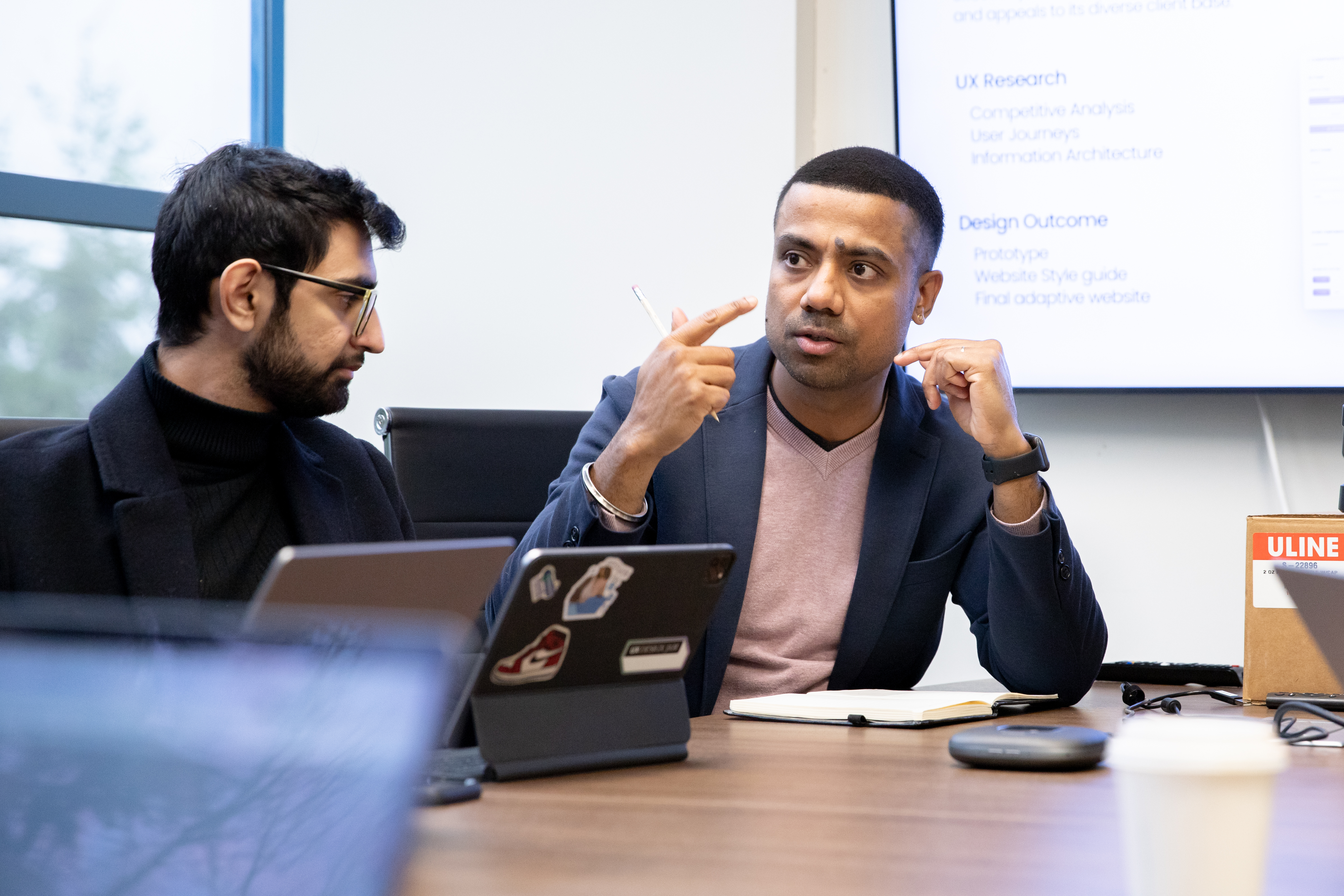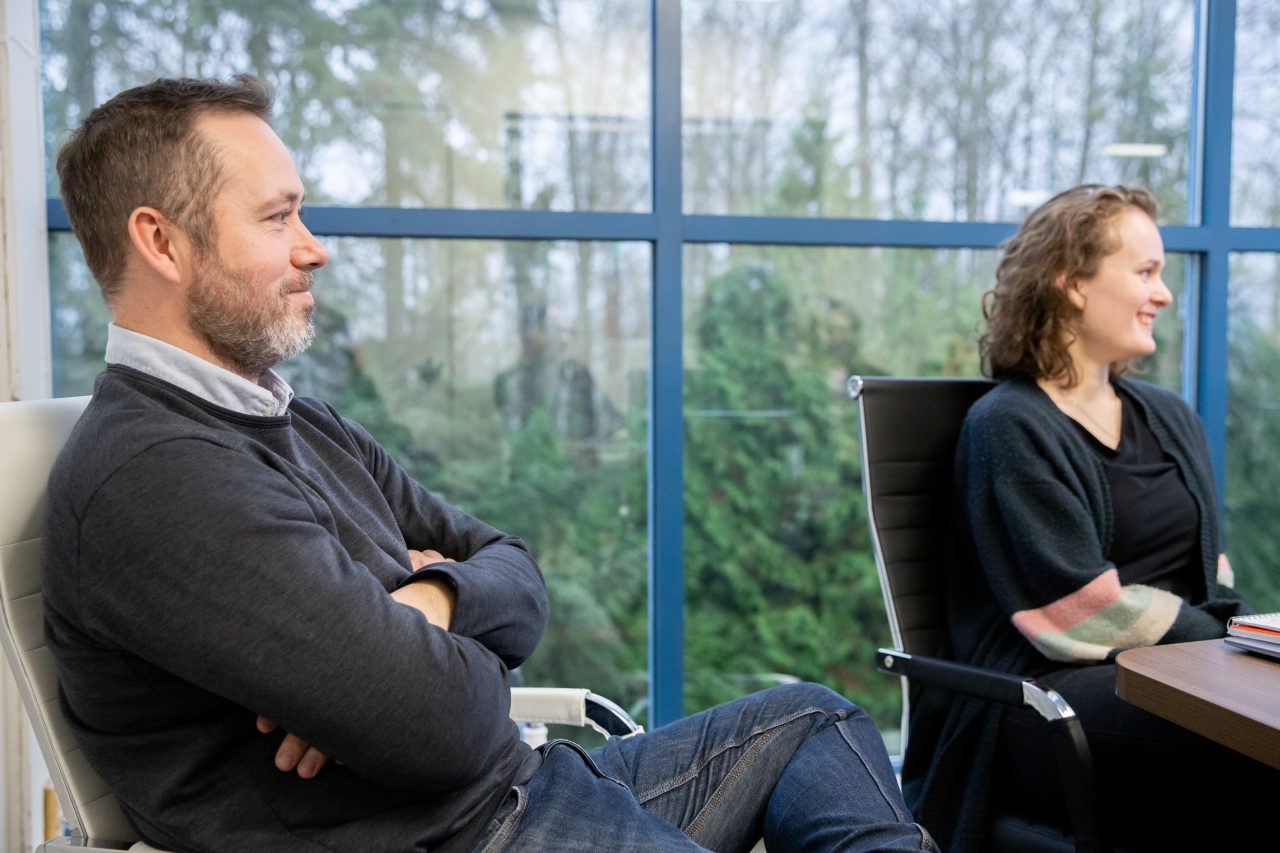Design Students Collaborate to Develop New Brand Identity for Anodyne Chemistries

ECU student Pritam Paul (right) and Asad Aftab meet with Anodyne Chemistries founders. (Photo by Perrin Grauer)
Posted on | Updated
The Mitacs-funded professional practice project saw the student team work with the sustainable chemicals startup to produce a holistic package of brand assets.
Master of Design students from across design programs at Emily Carr University of Art + Design (ECU) recently collaborated to create a brand identity for BC-based startup Anodyne Chemistries.
Xi Qiu (MDes 2025), a recent grad who was a student at the time of the project, assisted in developing Anodyne’s new visual brand guidelines, ensuring consistency across all the visual elements produced by the team.
“Working as a designer in a professional practice, especially within a dynamic and collaborative environment like Anodyne, was incredibly inspiring,” says Xi.
“The collaboration was both enriching and motivating as we engaged directly with clients and immersed ourselves in real-world design challenges. By understanding Anodyne’s vision and translating it into a visual identity, we gained experience aligning creative concepts with client objectives. As we approached graduation, it was exciting to see our design work come to life in the real world.”

ECU student Xi Qiu (right) hears from Anodyne at the start of the branding project. (Photo by Perrin Grauer)
Along with Xi, ECU students Asad Aftab (MDes 2025), Qianxuan Chen (MDes 2025), Joshita Nagaraj (MDes 2025), Pritam Paul (MDes 2025) and Yining Zhou (MDes 2025) worked on the project, each of them bringing a unique skillset and expertise to the work. They met with Anodyne to tour their Burnaby facility, see their scientists and engineers in action, and chat with staff and leadership to understand the company’s mission, goals and culture.
Over subsequent weeks, the students developed a suite of proposals for assets including logos, typography, packaging, slogans, marketing materials and a new website. The collaboration was generously co-funded by Anodyne and Mitacs and co-supervised by ECU industry liaison Alan Goldman and ECU faculty member Manuhuia Barcham.
Anodyne CEO Iain Evans notes the company was founded on principles including circularity and a commitment to supporting the local community. Its ultimate aim is to revolutionize the notoriously carbon-intensive chemical industry using enzyme technologies to sustainably and affordably produce chemicals for products consumers use daily, such as personal care items and household supplies, as well as for products used in agriculture, cosmetics and pharmaceuticals.

Anodyne Chemistries Chief Executive Iain Evans (left) and Chief Technology Officer Manou Davies listen to a presentation by the ECU student team at Anodyne's facility in Burnaby, BC. (Photo by Perrin Grauer)
Anodyne’s belief in sustainability as a socioeconomic value as well as an ecological one is part of what led them to connect with ECU.
“There’s amazing talent here in BC and working with Emily Carr University felt like working to foster greater relationships in the local ecosystem, hopefully helping shape it so talent can be retained in and around Vancouver,” Iain says. “Plus, there is just a pace and an amount of productivity and passion with students that tends not to be present in more seasoned industry veterans. And there was great work done which, as a company set up by scientists and engineers, often took us in directions we didn’t anticipate.”
Pritam says he found his collaboration with fellow students likewise illuminating. Having worked in the design industry for 15 years prior to beginning his master’s degree studies at ECU, Pritam had already developed a robust understanding of his voice and goals as a designer. In fact, his abiding interest in sustainability as a theme led him to interview Iain for his thesis before working on Anodyne’s branding project.

(From L): Student team members Yining Zhou, Qianxuan Chen, Joshita Nagaraj, Pritam Paul and Asad Aftab tour Anodyne’s facilities with their teammates. (Photo by Perrin Grauer)
He contributed primarily to Anodyne’s new brand guidelines, offering tools including web content accessibility guidelines for future use of the colour scheme once the website is up and running.
“When designers work together, we all have different tastes and different ideas about what is right,” Pritam says. “But we worked very well together and even when we agreed to present options that were not to my individual taste, Anodyne knew exactly what they wanted. So, it was a good learning experience to see, okay, right, this is not about me, this is about our client. Which made it feel like we arrived in a good place at the end.”
Visit Anodyne Chemistries online to learn more about their work.
Find thesis works by this year’s Master of Design grads alongside the rest of the Class of 2025 now in the online version of The Show.